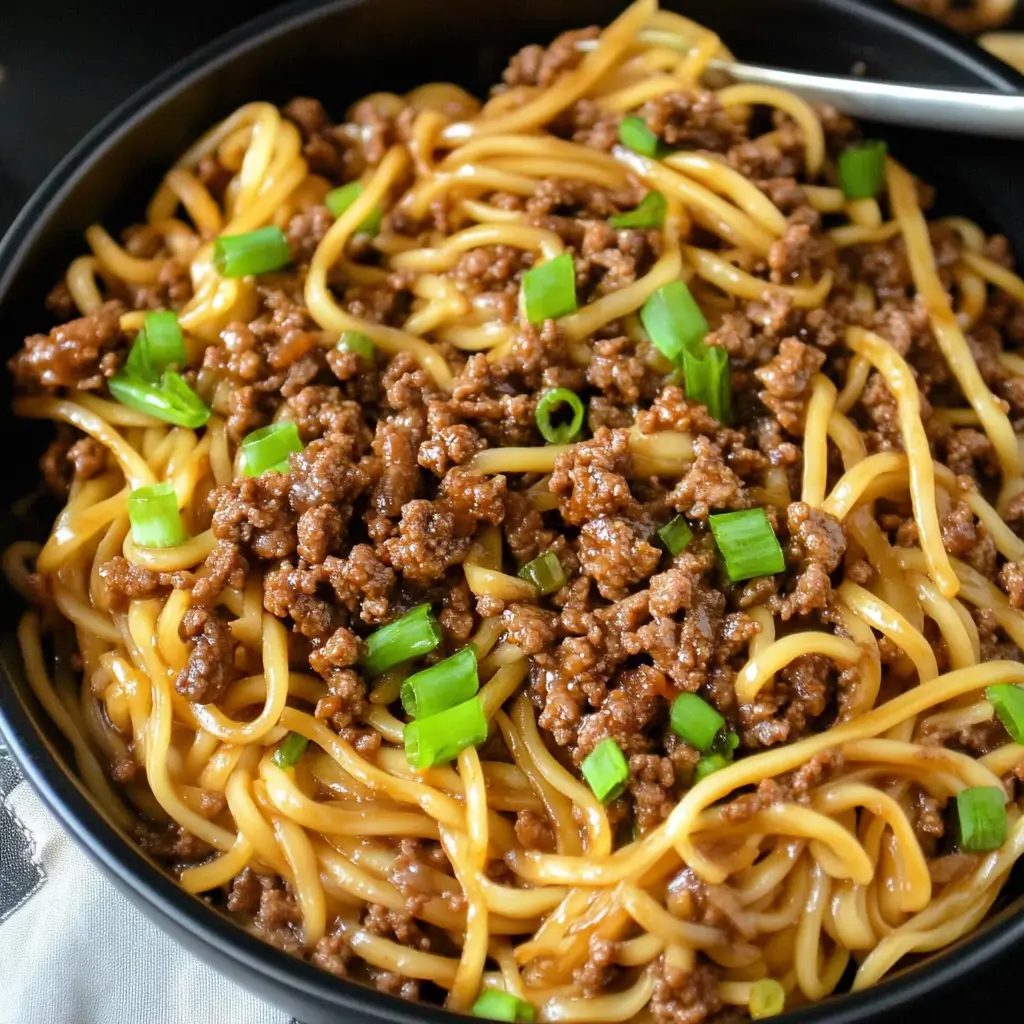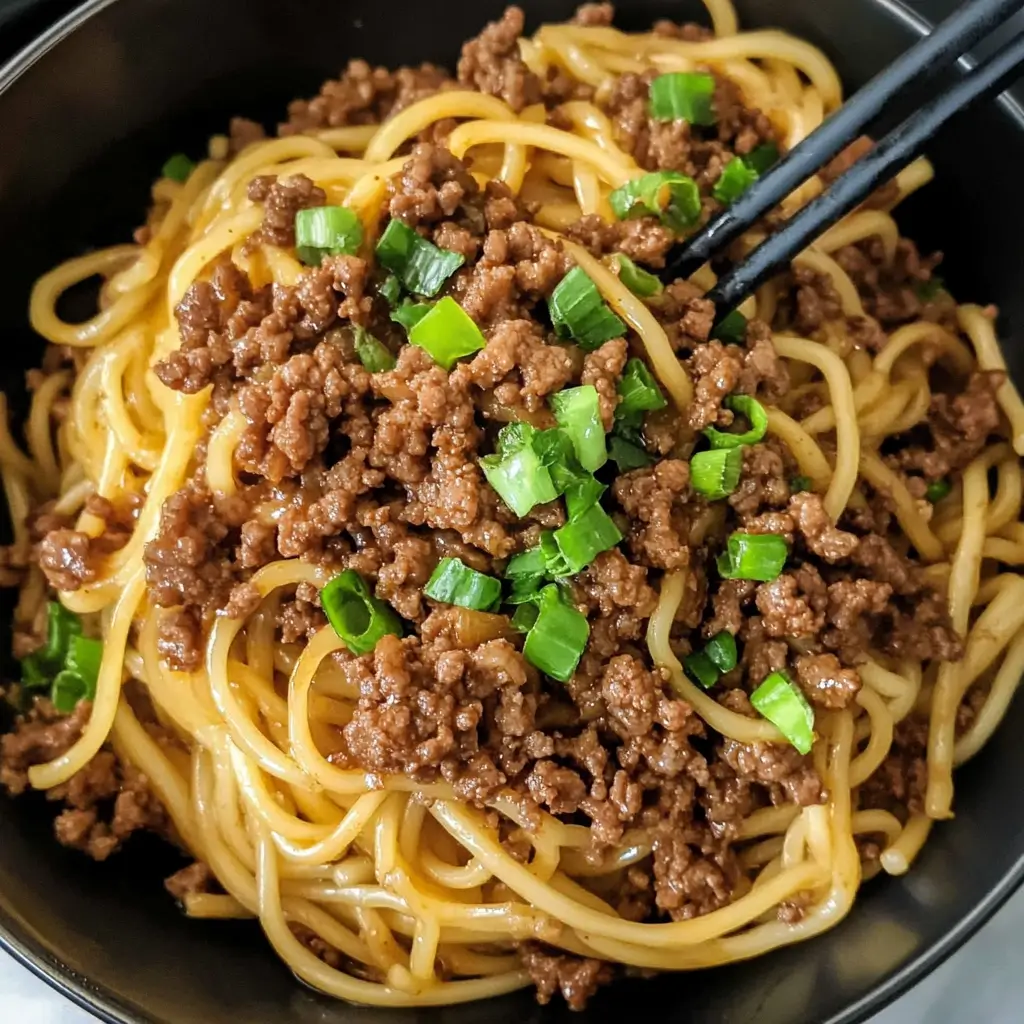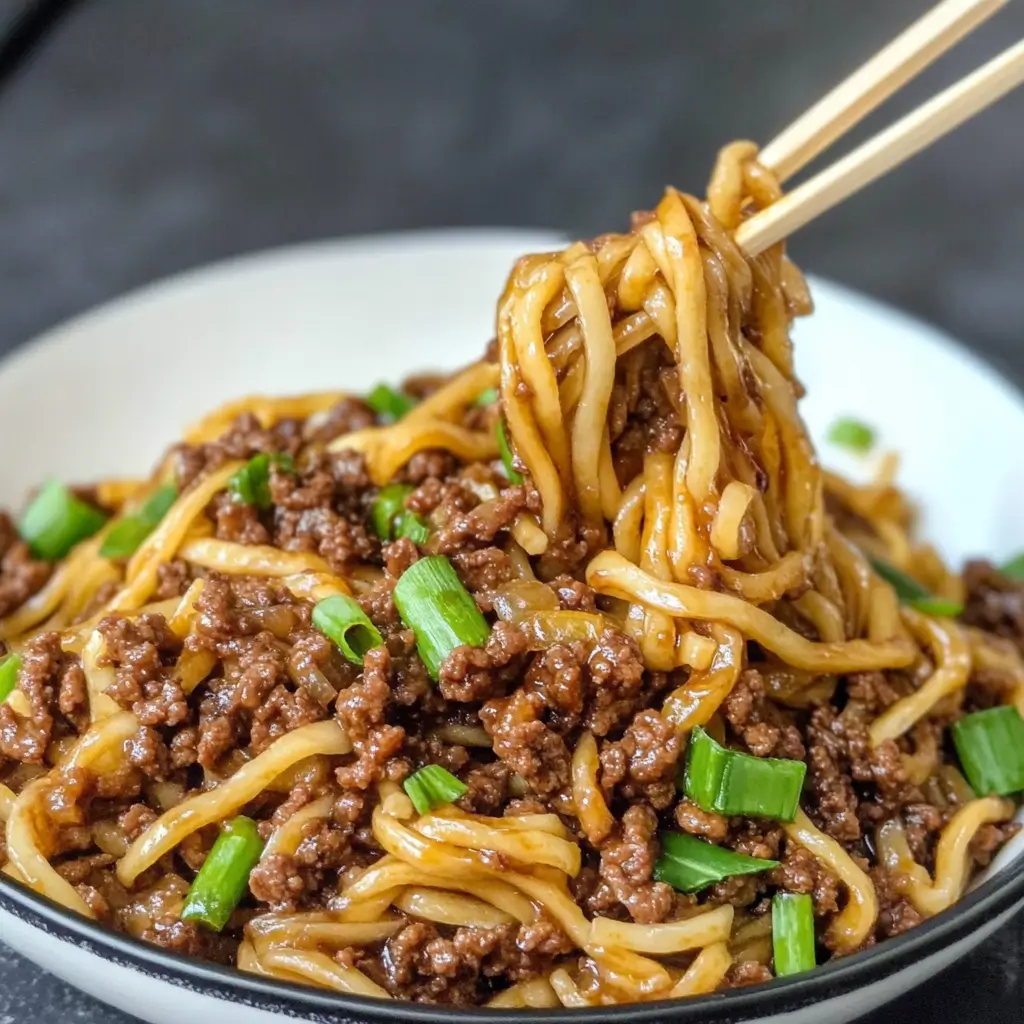Food has the unique ability to bring comfort and joy, and few dishes can deliver that like Mongolian ground beef noodles. Imagine a steaming plate of tender noodles, ground beef infused with savory spices, and a balance of sweet and salty flavors that make each bite irresistible. Whether you’re cooking for a weeknight family dinner or preparing a dish to impress guests, this Mongolian ground beef noodles recipe is sure to satisfy your cravings and become a regular in your recipe collection.
In this article, you’ll learn not only how to make this flavorful dish but also how to personalize it with variations and explore its unique ingredients. We’ll guide you through each step of the cooking process, provide nutritional insights, and even answer your frequently asked questions. By the end, you’ll feel confident enough to create your own version of Mongolian ground beef noodles, all while ensuring your dish is delicious and nutrient-rich.

Table of Contents
What Are Mongolian Ground Beef Noodles?
Before we dive into the recipe itself, let’s first understand what Mongolian ground beef noodles are and why they have become so popular.
Mongolian ground beef noodles blend the bold, savory flavors of Mongolian cuisine with stir-frying techniques that are commonly used in Chinese cooking. Despite the name, this dish doesn’t have direct ties to traditional Mongolian dishes but rather embodies the unique, flavorful profiles that draw inspiration from Mongolian-style meats and sauces.
In its simplest form, Mongolian ground beef noodles consist of ground beef, noodles (typically egg or rice noodles), a flavorful sauce, and various seasonings. The rich combination of ingredients like soy sauce, brown sugar, garlic, and ginger makes the dish a hit with anyone who enjoys savory-sweet Asian-inspired meals.
The popularity of this dish has skyrocketed in recent years because it’s quick to prepare, easily customizable, and deeply satisfying. The ability to swap out ingredients based on what you have in your kitchen makes it a perfect go-to recipe for busy weeknights or casual dinners.
Ingredients for Mongolian Ground Beef Noodles Recipe
Creating the perfect Mongolian ground beef noodles starts with gathering the right ingredients. Here’s a breakdown of everything you’ll need to prepare this tasty dish.
Key Ingredients
- Ground Beef – The star of the dish, ground beef adds richness and a hearty texture. You can opt for lean ground beef or a fattier version depending on your preference.
- Noodles – Egg noodles are the most common choice, but rice noodles are also a great option, particularly if you prefer a lighter dish.
- Soy Sauce – The base for the sauce, soy sauce provides saltiness and depth of flavor, crucial for a savory dish.
- Brown Sugar – This ingredient balances the savory flavors with a touch of sweetness, creating the signature taste of Mongolian dishes.
- Garlic and Ginger – These aromatic ingredients add essential layers of flavor, making the dish fragrant and inviting.
- Green Onions – Fresh green onions are used as a garnish, adding a pop of color and a light, sharp taste.
- Optional Vegetables – For extra flavor and texture, consider adding bell peppers, carrots, or mushrooms.
Ingredients Breakdown Table
| Ingredient | Quantity | Notes |
|---|---|---|
| Ground Beef | 1 lb (450g) | Lean or fatty, based on preference |
| Noodles | 8 oz (225g) | Egg noodles or rice noodles |
| Soy Sauce | 3 tbsp | Low-sodium is a healthier option |
| Brown Sugar | 1 tbsp | Adjust based on sweetness preference |
| Garlic | 3 cloves | Minced |
| Fresh Ginger | 1 tbsp | Grated |
| Green Onions | 2 stalks | Chopped for garnish |
The key to a successful Mongolian ground beef noodle dish is using the freshest ingredients possible. For an added boost of flavor, you can experiment with different spices or seasonings to make the dish your own.
How to Make Mongolian Ground Beef Noodles
Now that you’ve gathered your ingredients, let’s walk through the steps to make Mongolian ground beef noodles.
Step-by-Step Instructions
1. Cook the Noodles
Start by boiling the noodles according to the package instructions. Egg noodles or rice noodles typically cook in about 5–7 minutes. Once they are cooked, drain the noodles and set them aside.
2. Prepare the Ground Beef
In a large skillet or wok, heat a bit of oil over medium-high heat. Add the ground beef and cook it, breaking it apart with a spatula as it browns. Once fully cooked (about 7–10 minutes), drain any excess fat.
3. Make the Sauce
In the same skillet, add the minced garlic and grated ginger, sautéing them for about a minute until they become fragrant. Next, add the soy sauce, brown sugar, and any additional seasonings you like (such as a pinch of red pepper flakes for heat). Stir everything together until the sugar dissolves, creating a savory sauce.
4. Combine Noodles and Beef
Add the cooked noodles into the skillet with the beef and sauce. Toss everything together to ensure the noodles are coated evenly with the sauce and beef.
5. Garnish and Serve
Once the noodles are well-mixed with the sauce and beef, garnish with freshly chopped green onions. Serve immediately while hot.
Cooking Tips
- Customize the Sweetness: The brown sugar helps balance the saltiness of the soy sauce, but you can adjust the amount of sugar based on your taste.
- Extra Vegetables: Feel free to add vegetables like bell peppers, mushrooms, or snap peas to enhance the dish’s flavor and texture.
- Add Heat: If you prefer a spicier dish, include some chili paste, sriracha sauce, or red pepper flakes to bring the heat.

Variations and Customizations for Mongolian Ground Beef Noodles
While this recipe is delicious as is, there are many ways to modify it based on your preferences. Here are some popular variations:
Substitute Proteins
While ground beef is the traditional choice for this dish, you can easily swap it out for other proteins. Ground chicken, turkey, or pork work wonderfully in this recipe and provide a leaner option. For a completely different twist, try tofu or tempeh for a plant-based meal.
Add Vegetables for Extra Flavor
Adding vegetables not only boosts the nutritional value of your meal but also enhances its flavor. Some great options include:
- Bell Peppers: Add vibrant color and sweetness.
- Carrots: Shredded carrots bring crunch and a subtle sweetness.
- Mushrooms: These absorb the sauce and add a savory, earthy taste.
- Spinach: Stir in some spinach for added greens that wilt nicely into the noodles.
Make It Spicy
If you like your meals with a little heat, consider incorporating some chili paste, red pepper flakes, or a few dashes of sriracha sauce. Spice lovers will appreciate the extra kick, which complements the sweetness of the dish.
Vegan or Vegetarian Version
If you’re following a plant-based diet, simply replace the ground beef with tofu or tempeh, and ensure you’re using a plant-based soy sauce for the sauce. You can also add a variety of vegetables to make this version just as satisfying.
Health Considerations and Nutritional Information
Mongolian ground beef noodles are a balanced meal that combines protein, carbohydrates, and fats. However, like any dish, there are ways to make it healthier depending on your dietary needs.
Nutritional Breakdown
- Calories: Approximately 400–500 calories per serving (depending on the type of noodles and amount of oil used).
- Protein: Ground beef provides a good source of protein, essential for muscle growth and repair.
- Carbohydrates: Noodles contribute to the carb count, giving you the energy needed throughout the day.
- Fats: The fat content can vary based on the cut of beef you use. Opt for lean ground beef if you’re looking to reduce fat intake.
Healthier Substitutes
- Lower-Sodium Soy Sauce: Opt for a low-sodium soy sauce to reduce the sodium content of the dish.
- Whole Wheat Noodles: If you prefer a whole-grain option, whole wheat noodles provide more fiber than traditional egg noodles.
- Ground Turkey or Chicken: For a leaner option, substitute the ground beef with ground turkey or chicken.
Why You Should Try This Recipe
Mongolian ground beef noodles offer a unique combination of flavor, texture, and convenience. Here’s why you should try this recipe:
Quick and Easy to Make
This dish can be prepared in less than 30 minutes, making it an ideal choice for busy weeknights. With minimal prep and cooking time, you’ll have a delicious, home-cooked meal in no time.
Customizable to Your Taste
The recipe is highly adaptable. Whether you want to swap in a different protein, add more vegetables, or adjust the flavor profile, you have the flexibility to make it your own.
Perfect for Meal Prep
Mongolian ground beef noodles are great for meal prepping. You can make a big batch and store it in the fridge for several days. The flavors continue to develop, and it reheats well, making it a perfect dish for lunch or dinner throughout the week.

Frequently Asked Questions (FAQs)
Can I make Mongolian ground beef noodles ahead of time?
Yes, you can make Mongolian ground beef noodles ahead of time. The dish stores well in the refrigerator for up to 3 days. Simply reheat in the microwave or on the stove before serving. The flavors will even deepen after sitting for a day or two, making it perfect for meal prep.
Can I use gluten-free noodles for this recipe?
Absolutely! You can use gluten-free noodles such as rice noodles, soba noodles, or gluten-free pasta. Just make sure to adjust the cooking time according to the type of noodles you choose to maintain the right texture.
Is this recipe spicy?
The standard recipe isn’t spicy, but you can easily adjust the heat level. If you prefer spice, simply add chili flakes, hot sauce, or chili paste while cooking to customize it to your taste.
Conclusion
Mongolian ground beef noodles are more than just a meal; they are a delightful combination of flavors that will satisfy your cravings and provide a fulfilling dining experience. With the flexibility to customize ingredients and the ease of preparation, this dish is perfect for any occasion, whether it’s a casual weeknight dinner or a special gathering.
Now that you know how to make this simple yet flavorful dish, why not give it a try? Whether you follow the traditional recipe or put your own twist on it, you’re sure to enjoy every bite. So, grab your ingredients and start cooking—you won’t regret it!

